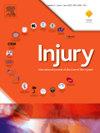Low-grade infections in nonunion of the femur and tibia without clinical suspicion of infection – Incidence, microbiology, treatment, and outcome
IF 2.2
3区 医学
Q3 CRITICAL CARE MEDICINE
Injury-International Journal of the Care of the Injured
Pub Date : 2025-02-01
DOI:10.1016/j.injury.2024.112137
引用次数: 0
Abstract
Treatment algorithms for fracture nonunion depend on the presence or absence of bacterial infection. However, it is often impossible to identify infection preoperatively. While some infections may present with clinical signs of infection, low-grade infections lack infection signs and have a clinical presentation similar to aseptic nonunion. The clinical relevance of low-grade infection in nonunion is not entirely clear. Therefore, the aim of this study was to evaluate the role of low-grade infection in the development and management of lower extremity nonunion.
A prospective multicenter clinical study enrolled patients with femoral or tibial shaft nonunion and regular healed fractures, scheduled for nonunion revision and routine implant removal, respectively. Preoperatively, serum markers including C-reactive protein (CRP), leukocytes, and procalcitonin were determined, clinical infection signs were recorded, and a suspected septic or aseptic diagnosis was made prior to surgery and further diagnostics. Tissue samples were collected for microbiology and histopathology, and osteosynthesis material for sonication. Nonunion patients were followed for twelve months, during which the definitive diagnosis of “septic” or “aseptic” nonunion was made according to diagnostic criteria for fracture-related infection.
One hundred and ten patients with nonunion and 34 patients with regular healed fractures were included. Sixty-two nonunion patients were diagnosed as aseptic, 22 with expected and confirmed infection, and 23 with unexpected low-grade infection. Three patients had an unclear diagnosis. Low-grade infection was detected in 28 % of presumed aseptic nonunion patients. Sensitivity and specificity for the suspected diagnosis were 49 % and 95 %, respectively. The suspected diagnosis had a significant impact on revision strategy. All medians of the preoperative blood values were within the reference ranges except for CRP, which was slightly elevated in the expected and confirmed infected nonunion group. Expected and confirmed septic nonunion and unexpected low-grade infected nonunion demonstrated a similar bacterial spectrum. While 10 % of patients with aseptic nonunion required follow-up surgeries, re-operation rates were higher in patients with low-grade infection and expected and confirmed infection at 30 % and 64 %, respectively. Patients with low-grade infections were treated less frequently with systemic antibiotics and for a shorter duration than patients with expected and confirmed infections, with no significant difference in healing rate which was 83 % in low-grade and 62 % in expected and confirmed infections. The healing rate of aseptic nonunion was 90 %. A limitation of this study is the limited number of tissue samples for microbiological and histopathological diagnostics in the suspected aseptic nonunion cohort, which may have led to an underestimation of the low-grade infection rate.
Our findings suggest that unexpected low-grade infection is frequently associated with nonunion. While expected and confirmed infected nonunion differs significantly from aseptic nonunion, low-grade infected nonunion is very similar to aseptic nonunion, except for intraoperative bacterial detection. In addition to antibiotic therapy, surgical nonunion revision with implant exchange and debridement appears to be highly effective in achieving consolidation of low-grade infected nonunion.
股骨和胫骨非愈合中的低度感染--发病率、微生物学、治疗和结果。
骨折不愈合的治疗方法取决于是否存在细菌感染。然而,术前往往无法确定是否存在感染。有些感染可能会出现感染的临床症状,而低度感染则没有感染症状,临床表现与无菌性骨折不愈合相似。低度感染与无菌性骨折的临床相关性尚不完全清楚。因此,本研究旨在评估低度感染在下肢骨不连的发生和治疗中的作用。这项前瞻性多中心临床研究招募了股骨干或胫骨干不愈合患者以及常规愈合骨折患者,分别计划进行不愈合翻修和常规植入物取出。术前测定血清标志物,包括C反应蛋白(CRP)、白细胞和降钙素原,记录临床感染征兆,在手术和进一步诊断前做出疑似化脓性或无菌性诊断。采集组织样本进行微生物学和组织病理学检查,并采集骨合成材料进行超声检查。在此期间,根据骨折相关感染的诊断标准,对 "化脓性 "或 "无菌性 "骨不连患者进行明确诊断。其中包括 110 名骨折未愈合患者和 34 名正常愈合的骨折患者。62名骨折不愈合患者被诊断为无菌性感染,22名患者被确诊为预期感染,23名患者被确诊为意外低度感染。有 3 名患者诊断不明确。在 28% 的推定无菌性骨折患者中发现了低度感染。疑似诊断的敏感性和特异性分别为 49% 和 95%。疑似诊断对翻修策略有重大影响。除 CRP 略有升高外,所有术前血值的中位数都在参考范围内。预期和确诊的化脓性 nonunion 与意外的低度感染性 nonunion 表现出相似的细菌谱。虽然 10% 的无菌性骨折患者需要进行后续手术,但低度感染和预期及确诊感染患者的再次手术率较高,分别为 30% 和 64%。与预期感染和确诊感染患者相比,低度感染患者接受全身抗生素治疗的频率较低,持续时间也较短,但愈合率没有明显差异,低度感染患者的愈合率为 83%,预期感染和确诊感染患者的愈合率为 62%。无菌性骨折的愈合率为 90%。这项研究的局限性在于,在疑似无菌性骨髁脱位患者中,用于微生物学和组织病理学诊断的组织样本数量有限,这可能会导致低级别感染率被低估。我们的研究结果表明,意外的低度感染经常与无趾骨畸形有关。虽然预期的和确诊的感染性非椎体终结与无菌性非椎体终结有很大不同,但低度感染性非椎体终结与无菌性非椎体终结非常相似,只是术中细菌检测除外。除抗生素治疗外,通过植入物交换和清创术进行非愈合翻修手术似乎对巩固低度感染性非愈合非常有效。
本文章由计算机程序翻译,如有差异,请以英文原文为准。
求助全文
约1分钟内获得全文
求助全文
来源期刊
CiteScore
4.00
自引率
8.00%
发文量
699
审稿时长
96 days
期刊介绍:
Injury was founded in 1969 and is an international journal dealing with all aspects of trauma care and accident surgery. Our primary aim is to facilitate the exchange of ideas, techniques and information among all members of the trauma team.

 求助内容:
求助内容: 应助结果提醒方式:
应助结果提醒方式:


